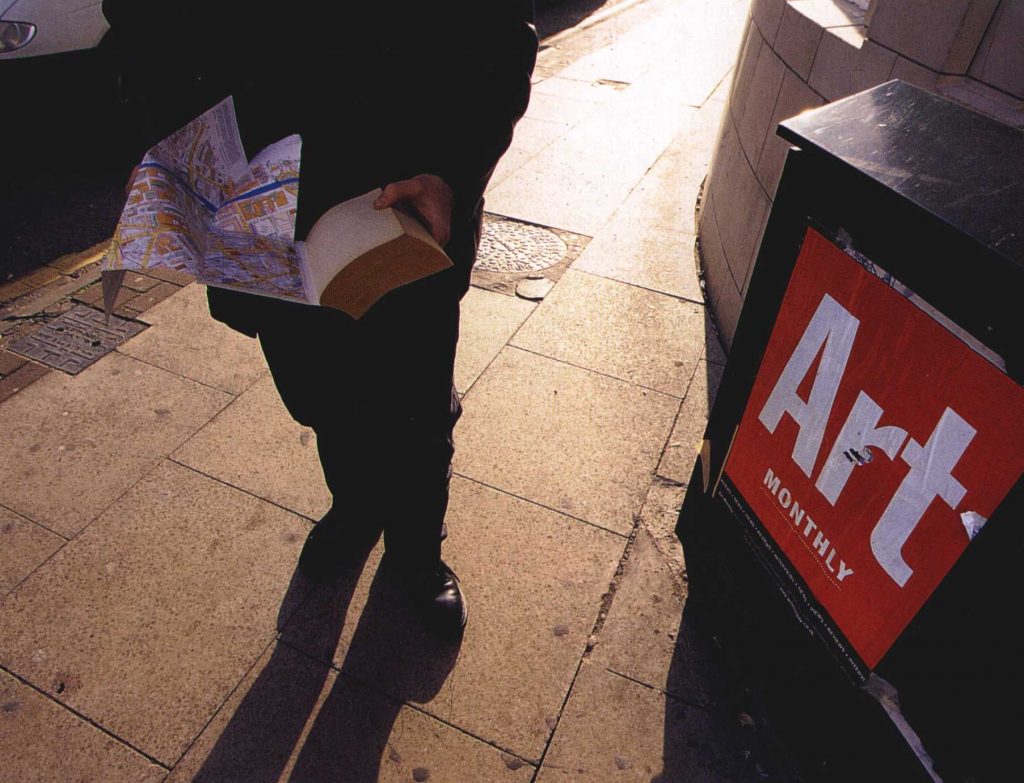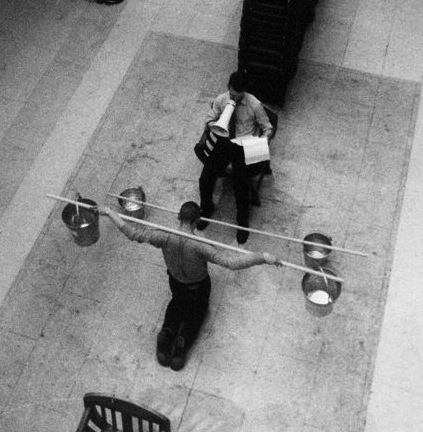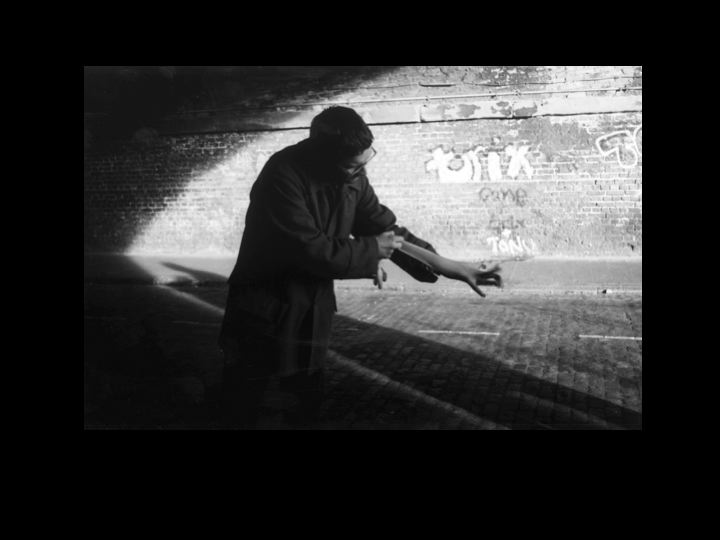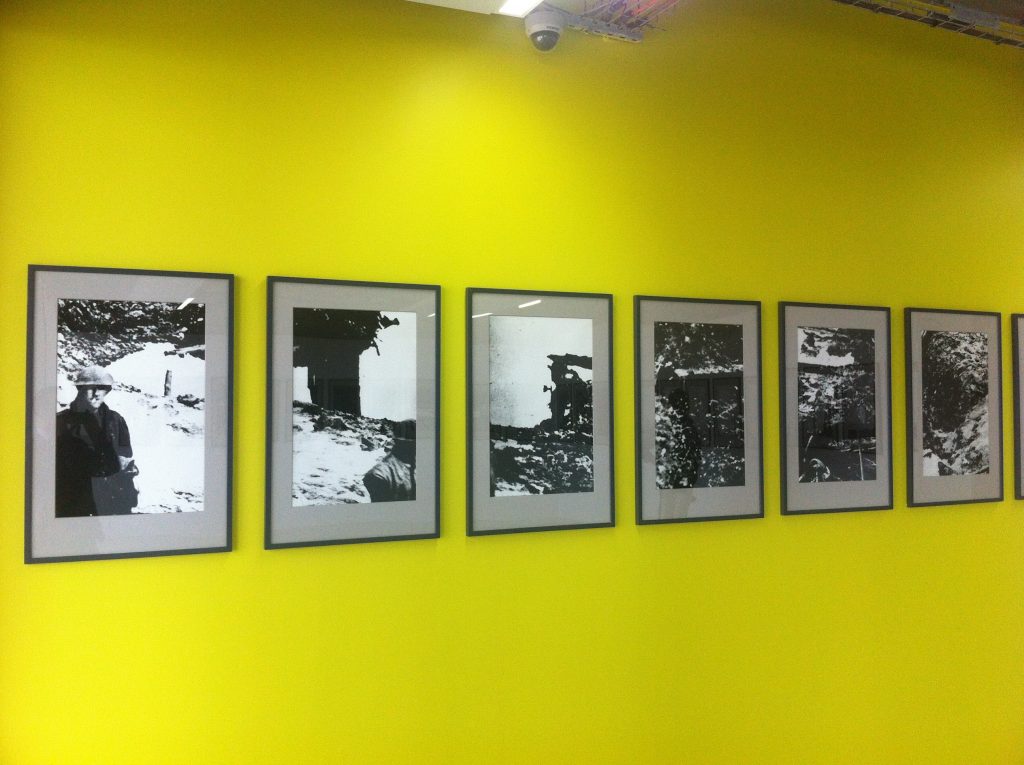
Tim Brennan, ‘Reading Capital’ manoeuvre, ‘You Are Here’, Holden Gallery, Manchester (UK), 2000. Photo Credit: Gary Kirkham.
As part of the release of my book, Walking as Artistic Practice (pre-orders now open for softcover shipping in April!), I’m going to be publishing some brief interviews with the various artists, authors, researchers, creatives, collectives, and platforms whose art practice, written material, or other works I cite and mention.
My 22nd interview in this series is with Tim Brennan, an English artist active since the 1980’s. His work is not limited to one mode of production and includes the visual and sonic. Performance and the performative are consistent threads in his international practice.
EM: First, thank you for chatting with me about your project Vedute Manoeuvre (2011). I cite this project in chapter three (Observational Walking) in the subsection on “Sight,” mentioning the use of “view cards.” How would you describe this project for people who might not be familiar with it?
TB: I made Vedute Manoeuvre for the 54th Venice Biennale in 2011 (Gervasuti Foundation exhibition: The Knowledge curated by James Putnam and Eiko Honda). I wanted to make a work that could be engaged with at any time in Venice and one that wasn’t limited to the Biennale timeframe and so I made a guided walk that focuses on the iconic Piazza San Marco (St. Mark’s Square). I gained the rights to reproduce a series of Canelletto depictions of the Piazza as A4 cards. There are 14 cards in total. On the reverse of each card, I described the directions a walker should take and where they should stop to read a quotation that followed on. The quotations were drawn from a range of sources, including a description of the Futurist Manifesto and its launch from the top of the Campanile (belltower) in the early 20th Century, to an extract from John Ruskin’s Stones of Venice in which he advocates using cheese as a sculpting material with which to create/recreate architectural models.
The word ‘vedute’ in the title translates from the Italian into English as ‘views’. Canelletto as a ‘veduta’ – a painter of views. I wanted to create a work that revealed the multiplicity and complexity of the word. I chose Canaletto’s paintings as, at first glance they appear to give a pre-photographic sense of realism to the journey. The idea being that walker can use each painting to locate themselves quite specifically in the location by marrying up an image with a view observed in person in the Piazza. When you use the cards, it is then revealed that Caneletto made artistic decisions, moving objects and adding and subtracting aspects to arrive at the best formal arrangement on a canvas.
The collision of quotations with each other and aspects of the Piazza observed prompt the walker to think and consider themes, topics, contexts and their own position in time and space. Along the bottom of each card runs a critical essay by writer Dr. Heather Yeung.

Tim Brennan, ‘Impasse’ performance with David Coxon, ‘Artists and War’, Ferens Art Gallery, Hull (UK), 1989. Photo Credit: Simon Drury.
EM: What are your thoughts on walking as artistic practice?
TB: First and foremost, I am an artist. I use walking as a device, it’s just one performative vehicle with which to make works of imagination. The first manoeuvre. I made was at the Interzone Performance Biennale in Quebec in 1992. The performance involved some walking and the organisers and Canadian critics suggested that my work was a manoeuvre. I then developed this idea of the manoeuvre and began using the walk form as the main tool. The manoeuvre is a discursive performance and tends not to be body centred. So, this is how my use of walking as an aspect of my art practice began. At the time there were very few artists using walking beyond Richard Long and Hamish Fulton who were the go-to reference points. They had tended in the majority to use walking in close relation to ideas of nature and I wanted to bring the use of walking into environments that were generally associated with ideas of ‘nature’. There were other instances of artists using a walk but less in a concentrated fashion. I’m thinking here of Gunther Brus’s Vienna Walk of 1965 or, in terms of a tour, Robert Smithson’s Tour of the Monuments of Passaic in 1967. I had the aim to expand on the work of Long and Fulton to include urban, semi-rural, interior and exterior locations. I also wanted to find a platform of presentation that did not rely upon the ‘gallery’. The sense that a guided walk could eschew the terms of the physical gallery with an itinerary became a solution.
Over the years the use of walking as artistic practice has caught on and become something of a burgeoning industry. It’s quite common to see artists describing themselves as having a walking practice and to see networks and literature on the topic. Some of this has been driven by the field of literature. In the early 1990’s I soon discovered that there was a tradition of writers who would utilise walking in their practice. The novels of Peter Ackroyd and the closely associated work of Iain Sinclair and at the time the sociologist Chris Janks were focusing London as their main site. Others followed. But there weren’t any in the visual art world.
A lot of walking practice among artists and writers tends to lean on the ideas of the ideas of Situationist International and you often hear the terms psychogeography and derive being used. You sometimes hear the term flaneur as a reference point being cited but less so currently. This historical matrix seems very appealing to academia. They are interesting terms but what drives me is a consideration of the environment as having a grammatical construction: as being structured as a language and how the use of walking is a simple tool with which to uncover its layered fragments. Fragments that are disjointed and dislocated and when assembled form discursive patterns. So ‘drifting’ through the environment and ‘getting lost’ are less important for me as would be using walking as a mode of imaginative pseudo-archaeology.

Tim Brennan, ‘A Cut’ manoeuvre, Royal London Hospital, Camerawork, London (UK), 1997 Photo Credit: Geoff Cox.
EM: Can you tell us about any recent or upcoming projects you are excited about?
TB: I am currently developing three manoeuvres for the Oxford Road area of Manchester city centre (UK). I’ve produced 9 published itineraries since the 1990s (including Vedute in 2011 and Museum of Angels in 2003 for the British Museum). This new Corridors guidebook will form the 4th in a series of pocket travel companions that I began in 1999 with Guidebook: Three Manoeuvres by Tim Brennan in London E1/E2 (followed by Prospectus in the same year and Enchiridion in 2011).
The guidebook explores a quarter of Manchester known as The Oxford Road Corridor in which Universities, art, poetry and music venues, public sculpture, the main hospital, and The Central Library are located. The publications weave in and out and revolve around the three main topics of Knowledge, Culture and Sustainability as three walks of imagination. Corridors will be launched in spring 2024 with accompanying live versions of each walk that I will lead.

Tim Brennan, ‘Fortress Europe 11-42’ 36 Photographs, collection: Centre Regionale de la Photographie, Nord pas de Calais, (Fr), 1990. Photo Credit: Tim Brennan.